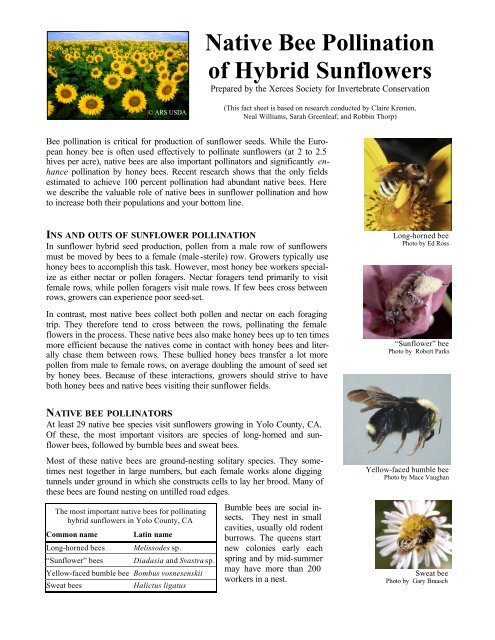Native Bee Pollination of Hybrid Sunflowers - The Xerces Society
Native Bee Pollination of Hybrid Sunflowers - The Xerces Society
Native Bee Pollination of Hybrid Sunflowers - The Xerces Society
Create successful ePaper yourself
Turn your PDF publications into a flip-book with our unique Google optimized e-Paper software.
<strong>Native</strong> <strong>Bee</strong> <strong>Pollination</strong><strong>of</strong> <strong>Hybrid</strong> <strong>Sunflowers</strong>Prepared by the <strong>Xerces</strong> <strong>Society</strong> for Invertebrate Conservation© ARS USDA(This fact sheet is based on research conducted by Claire Kremen,Neal Williams, Sarah Greenleaf, and Robbin Thorp)<strong>Bee</strong> pollination is critical for production <strong>of</strong> sunflower seeds. While the Europeanhoney bee is <strong>of</strong>ten used effectively to pollinate sunflowers (at 2 to 2.5hives per acre), native bees are also important pollinators and significantly enhancepollination by honey bees. Recent research shows that the only fieldsestimated to achieve 100 percent pollination had abundant native bees. Herewe describe the valuable role <strong>of</strong> native bees in sunflower pollination and howto increase both their populations and your bottom line.INS AND OUTS OF SUNFLOWER POLLINATIONIn sunflower hybrid seed production, pollen from a male row <strong>of</strong> sunflowersmust be moved by bees to a female (male -sterile) row. Growers typically usehoney bees to accomplish this task. However, most honey bee workers specializeas either nectar or pollen foragers. Nectar foragers tend primarily to visitfemale rows, while pollen foragers visit male rows. If few bees cross betweenrows, growers can experience poor seed-set.In contrast, most native bees collect both pollen and nectar on each foragingtrip. <strong>The</strong>y therefore tend to cross between the rows, pollinating the femaleflowers in the process. <strong>The</strong>se native bees also make honey bees up to ten timesmore efficient because the natives come in contact with honey bees and literallychase them between rows. <strong>The</strong>se bullied honey bees transfer a lot morepollen from male to female rows, on average doubling the amount <strong>of</strong> seed setby honey bees. Because <strong>of</strong> these interactions, growers should strive to haveboth honey bees and native bees visiting their sunflower fields.Long-horned beePhoto by Ed Ross“Sunflower” beePhoto by Robert ParksNATIVE BEE POLLINATORSAt least 29 native bee species visit sunflowers growing in Yolo County, CA.Of these, the most important visitors are species <strong>of</strong> long-horned and sunflowerbees, followed by bumble bees and sweat bees.Most <strong>of</strong> these native bees are ground-nesting solitary species. <strong>The</strong>y sometimesnest together in large numbers, but each female works alone diggingtunnels under ground in which she constructs cells to lay her brood. Many <strong>of</strong>these bees are found nesting on untilled road edges.Yellow-faced bumble beePhoto by Mace Vaughan<strong>The</strong> most important native bees for pollinatinghybrid sunflowers in Yolo County, CACommon nameLong-horned bees“Sunflower” beesLatin nameMelissodes sp.Diadasia and Svastra sp.Yellow-faced bumble bee Bombus vosnesenskiiSweat beesHalictus ligatusBumble bees are social insects.<strong>The</strong>y nest in smallcavities, usually old rodentburrows. <strong>The</strong> queens startnew colonies early eachspring and by mid-summermay have more than 200workers in a nest.Sweat beePhoto by Gary Braasch
















